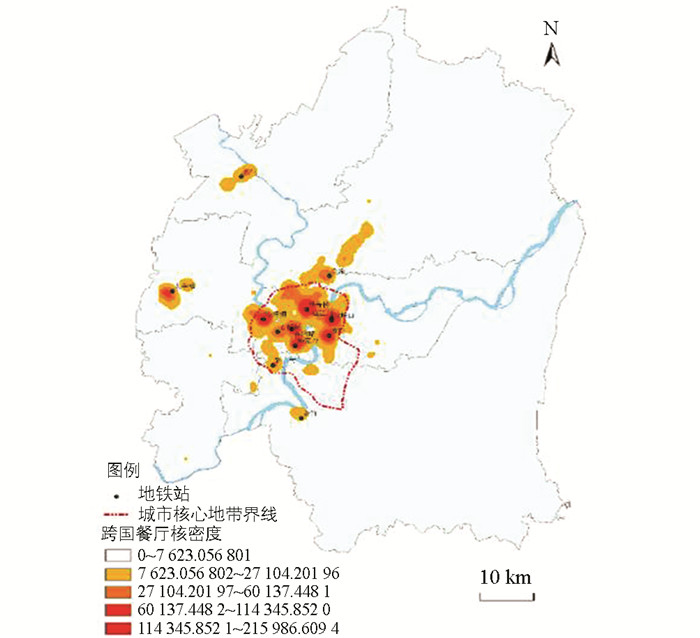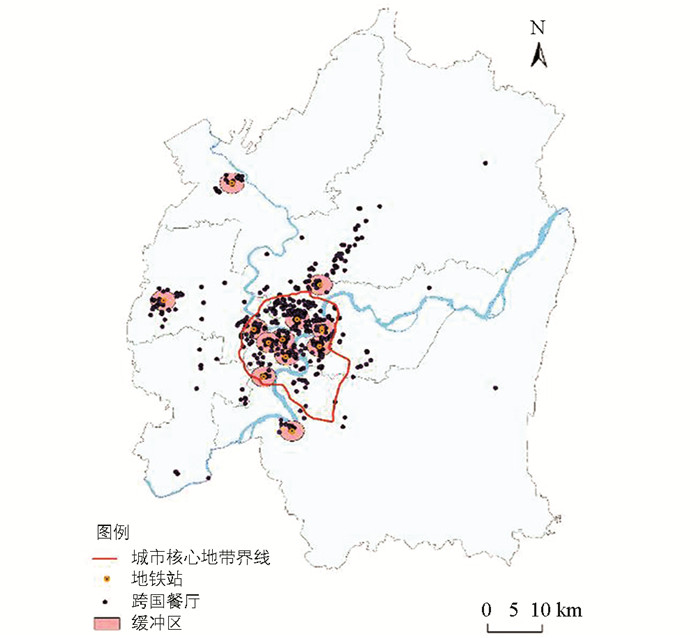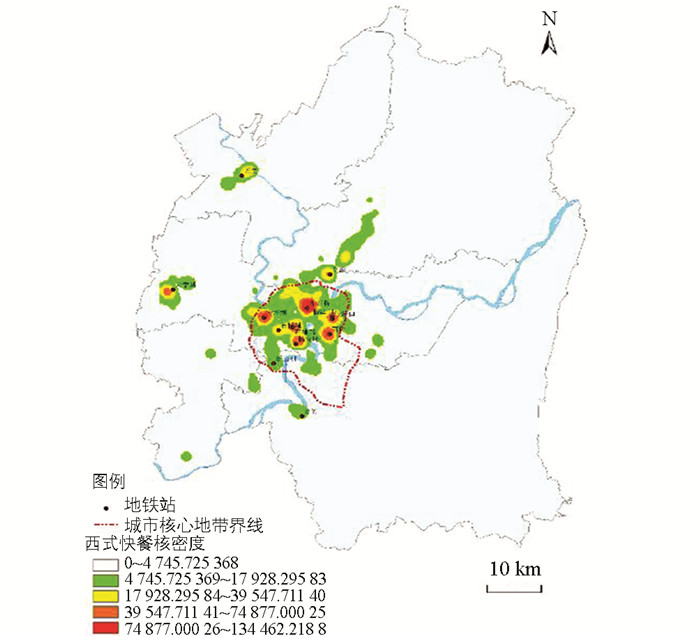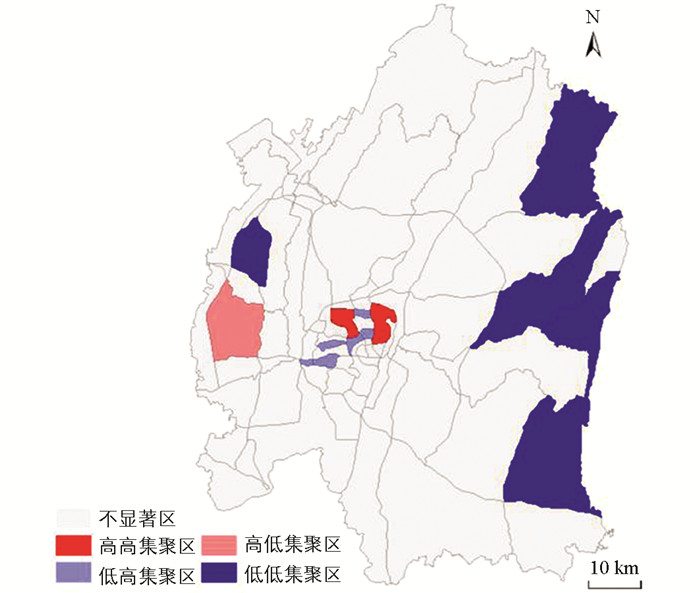-
自2001年中国加入世界贸易组织(WTO)以来,跨国要素持续进入中国各等级规模的城市,并对城市空间产生了重要影响[1].随着城市全球化进程的深入,跨国要素的类型已从跨国公司为代表的经济要素发展到以跨国餐厅、国际社区为代表的社会—文化—生活要素[2-3].以西餐厅为代表的跨国餐厅是最为典型的一类跨国社会文化要素,它反映了跨国文化、跨国生活要素在中国城市的传播和扩散[4].在城市全球化日益深入到社会生活层面的过程中,跨国餐厅在城市内部空间的扩展成为一个重要的表征要素[5].
对跨国餐厅空间分布展开研究可以揭示城市内部全球化作用密集区域的社会学特征,同时也是城市生活视角下城市全球化发展程度的外在表现.国外跨国餐厅的研究集中在文化特征[6]、消费者行为[7]及跨国餐厅与地方习俗、城市空间的互动关系[8],案例地多集中于欧美城市.国内在城市生活的餐饮研究领域,已有针对西安[9]、南京[10]、厦门[11]等城市的餐饮业空间分布特征和影响要素研究,揭示了区域经济水平、人口密度、交通便捷度和城市形态是餐饮业布局的重要因素[12].此外,有学者指出文化传统、旅游活动、商圈级别与规模是影响城市高档餐饮布局的因素[13].然而,这些研究未结合城市全球化发展过程中跨国要素聚合的城市餐饮业空间分布特征与影响要素分析,对中国城市的跨国餐厅发展和空间格局有待进一步充实与丰富.因此,本文从跨国饮食空间的视角,研究跨国餐厅的空间分布特征及影响要素,以揭示跨国餐厅在城市内部空间如何分布.换言之,社会生活领域的跨国要素会首先选择城市的哪些区位,而这些区位的经济、社会、文化特征又是怎样的?以此为研究问题,本文选取重庆市主城九区,结合大众点评网、高德地图等研究工具和手段,探索跨国餐厅的空间布局特征和影响因素,试图揭示全球化背景下内陆城市社会生活全球化的空间表现特征.
全文HTML
-
重庆辖38个区县(自治县),总面积8.24万km2,是典型的中国特大城市.重庆是中国重要的内陆中心城市,现今为“一带一路”和长江经济带两大国家发展战略的“Y形”连接点城市.在城市全球化发展过程中,重庆具有典范意义.一是其内陆城市的地理区位和山地城市形态,二是其独特的城市发展历史和城市地位.因此,选取重庆作为案例城市,研究城市社会生活全球化的空间表现可以揭示出与东南沿海城市不同的发展特征.重庆主城九区即重庆城乡总体规划中的都市区,是重庆市人口最为集中,经济最为发达的区域[14-15].主城九区是重庆城市发展的核心地带,也是城市全球化水平最高的区域,范围包括渝中区、大渡口区、江北区、南岸区、沙坪坝区、九龙坡区、北碚区、渝北区和巴南区,面积5 472.68 km2(图 1).
-
通过大众点评网、艺龙网获取跨国餐厅的基本数据.具体为在大众点评网内定位重庆市,根据“热门标签”之“西餐”,按行政区分别对重庆市主城九区跨国餐厅进行统计.在艺龙网内定位重庆市,按行政区分别对重庆市主城九区的西餐厅进行统计.共获取869家标签为“西餐”的跨国餐厅,剔除由于地址信息不全导致无法定位的10家跨国餐厅,获得有效数据为859家.之后,利用高德地图数据管理平台建立重庆市主城九区跨国餐厅空间数据库并导出数据,再导入ArcGIS,生成地图.
-
1) 核密度估计法
核密度估计法的基本思想是地理事件在空间点密度大的区域发生的概率大,在空间点密度低的区域发生的概率低[16],表达式如下:
式中:n为距离尺度范围内所包含的研究对象的数量;K(·)为核密度函数;h为距离阈值,即核密度估计法的尺度;d(x,xi)为两点之间的欧式距离.
2) 缓冲区分析
缓冲区分析是对一组地理要素按照设定的距离条件,在其周围形成具有一定宽度范围的多边形区域,分析区内的空间数据以获取数据在二维空间的扩展信息[17].地物Oo的缓冲区定义如下:
亦即Oo的半径R的缓冲区是全部距Oo的距离d小于等于R的点的集合.
为求证主城九区跨国餐厅的空间分布与地铁站的关系,以现有区域CBD或地铁站为原点,设置半径为2 km,进行缓冲区分析,以分析区内跨国餐厅的密集程度.
3) 空间自相关分析
空间自相关分析是一种统计检验方式,可以测量空间事物的分布是否具有相关性[18],表达式如下:
借助空间分析软件GeoDa,研究重庆市跨国餐厅在空间上的集聚与离散特征.首先,采用基于邻接规则的权重矩阵,通过999次随机检验,伪显著水平达到5%(p≤0.05)时,得到研究对象的全局自相关Moran's Ii指数值和检验值Zi;然后,通过LISA显著性局部自相关分析,得到研究对象的LISA分布特征图.
1.1. 研究区域
1.2. 数据获取
1.3. 研究方法
-
根据现有关于餐饮业空间分布的一般影响要素[11],选取区域经济发展水平、人口密度及商圈规模进行相关性分析,具体指标包括GDP、社会消费品零售总额、城镇居民人均可支配收入、人口密度和商圈零售总额(表 1),探索跨国餐厅数量特征因素的相关性程度.
-
重庆主城九区的跨国餐厅以西餐厅为主,具体可分为西式正餐、西式快餐两种类型.通过数量统计发现:渝北区跨国餐厅数量最多,为176家,占比20.49%,其次为江北区、渝中区、沙坪坝区,大渡口区、北碚区和巴南区数量较少(图 2).在跨国餐厅类型方面,主城九区共有281家西式正餐店和578家西式快餐店,占比分别为32.71%和67.29%.重庆主城跨国餐厅中,西式快餐的数量比西式正餐多,其中二者差别较大的为沙坪坝区、渝北区等(图 3).
相关性分析结果显示,跨国餐厅空间布局数量特征与地区生产总值、社会消费品零售总额相关性最大(表 2),分别为0.813 9,0.769 2,再次为各区商圈规模,相关性系数为0.663 2,城镇居民人均可支配收入、人口密度对跨国餐厅空间布局影响效果较差,相关性系数均低于0.5,分别为0.339 8,0.165 8.跨国餐厅类型特征方面,影响西式快餐与西式正餐相关性的因素表现出大体相同的特点,社会消费品零售总额、地区生产总值、商圈规模是影响西式正餐空间布局的主要因素,相关性程度分别为0.848 4,0.800 5,0.792 4,人口密度和城镇居民人均可支配收入对其影响较小,相关性低于0.6.而地区生产总值、社会消费品零售总额、商圈规模对西式快餐的空间布局影响较大,相关性程度均高于0.5,分别为0.779 3,0.686 0,0.558 0.
综上所述,地区经济发展水平是影响跨国餐厅空间布局特征的主要原因,其中地区GDP、社会消费品零售总额与各区跨国餐厅数量呈正相关关系.作为主城九区经济增长主要引擎的城市核心地带是跨国餐厅空间分布最集中的一个区域,跨国餐厅的数量高达600家,占比为69.85%.城市核心地带的跨国餐厅数量和密度都远远高于城市拓展地带.
具体来说,GDP反映了一个地区经济发展总体水平,影响着一个地区的经济活力、投资吸引力和居民消费购买力.主城九区经济较发达地区同时也是跨国餐厅数量众多,分布密集的地区.从跨国餐厅分布核密度图中可以看出,跨国餐厅分布密集的渝中区、江北区、渝北区、沙坪坝区等,2017年GDP均超过500亿元人民币,GDP最高的渝北区跨国餐厅数量也最多,为176家.
社会零售品消费总额反映地区消费水平和人口流量.社会消费品零售总额最高的地区——渝中区、渝北区、九龙坡区、江北区等,社会消费品零售总额超过了400亿元人民币,同时也是跨国餐厅数量最多分布最密集的地区.而巴南区、北碚区、大渡口区社会消费品零售总额均低于300亿元人民币,跨国餐厅数量也较少,如社会消费品零售总额最低的大渡口区,跨国餐厅仅为17家.
商圈是城市商业中心,集聚了各种商业类型,是城市商业增长极核和消费极核,吸引着大量消费者.商圈零售总额则反映着城市商业吸引力和发展水平,商圈零售总额越大,说明城市商业经济越发达,居民消费购买力越大.跨国餐厅作为一种餐饮业,是商圈主要餐饮类型之一.商圈零售总额最大的渝中区、沙坪坝区、江北区,同时也是跨国餐厅数量最多,核密度最大的区域.
城镇居民人均可支配收入对西式正餐空间布局影响程度较大,对西式快餐空间布局影响却较小.城镇居民人均可支配收入是直接决定居民消费水平高低的因素,西式正餐由于其消费价格高,一次性消费支出相对于西式快餐更高等原因,形成了消费门槛,对消费者有市场挤出效应.而西式快餐由于其大众化消费特点,消费价格低廉,消费市场广阔,所以对其空间布局影响程度较弱.
另外,高校在校生人数和各区人口年龄结构与跨国餐厅空间布局也有一定相关性.根据重庆市统计年鉴(2017),重庆市2017年在校大学生人数已达109.28万,全市义务教育及以上在校生人数为516.55万,学生尤其是大学生作为西餐的重要消费群体,影响着跨国餐厅的空间布局,如大学生数量众多的沙坪坝区和北碚区,各大学内部或周边跨国餐厅空间分布核密度大.人口年龄结构方面,18~35岁占比最大的是渝中区(28.52%),其跨国餐厅数量最多(176家),其次为九龙坡区,分别为19.73%,102家,18~35岁人口占比超过15%的沙坪坝区、巴南区、南岸区,跨国餐厅数量也都超过了100家,原因可能是18~35岁人口主要为大学生消费群体和白领阶层,其学习工作节奏快,受西方文化影响较强,对西餐文化接受度也更高.
2.1. 指标构建与解释
2.2. 数量与类型分布
-
重庆市主城九区跨国餐厅空间分布呈现“一个核心,多个次核心”的空间集聚特征,且主要集中在城市核心地带,呈现以江北区观音桥为核心,附近次核心围绕其布局的特点(图 4).这些核心及次核心空间布局最大的共性为都紧临区域重要轨道交通站点.跨国餐厅空间核密度核心为观音桥地铁站,次核心之一为位于解放碑南部的较场口地铁站和北部的临江门地铁站;另一个次核心为沙坪坝三峡广场,以沙坪坝地铁站为中心.其他行政区跨国餐厅核密度核心也紧临地铁站,大学城、九龙坡、南岸、北碚、大渡口、巴南分别以大学城地铁站、杨家坪地铁站、南坪地铁站、天生地铁站、新山村地铁站、金竹地铁站为核心,跨国餐厅集中分布于以这些地铁站为中心的2 km范围内(图 5).
西式正餐空间核密度和西式快餐空间核密度有着大体一致的分布格局,空间核密度以核密度极核为中心向外逐渐递减,表现出多个中心的特征.从西式正餐来看,其表现为“两核多心”的岛状空间分布格局,以解放碑、观音桥为两核,以沙坪坝三峡广场为次核心,以九龙坡杨家坪、南岸南坪、沙坪坝大学城、渝中石油路地铁站为中心,核密度向外递减(图 6).在城市核心地带内,主要分布在北部,南部由于城市开发建设尚不成熟而几乎没有跨国餐厅分布.在城市拓展地带内,形成了沙坪坝大学城、北碚区、渝北金渝地铁站和机场路沿线、巴南金竹地铁站,绕主城核密度聚集区“众星拱月”式分布.西式正餐在解放碑和观音桥形成了两个极核,二者都有便捷的地铁和道路交通,都聚集了大量大型购物广场,也是重要的旅游目的地.从西式快餐来看,其空间核密度分布格局总特征为“一核多心”,以观音桥为核密度极核,以解放碑、沙坪坝三峡广场和大学城、南岸南坪、九龙坡杨家坪、渝北金渝等为中心,向外连续递减发散(图 7).与西式正餐相比,西式快餐空间分布有3个较为显著的特征,一是西式快餐空间分布更为连续,在城市内部渗透得更深更远,二是西式快餐在机场路分布比西式正餐更为集中,三是西式快餐先于西式正餐扩散至主城以外的小城镇(图 7).
影响跨国餐厅布局于轨道交通站点的因素主要为社会经济发展水平和市场准入门槛.跨国餐厅集聚的轨道交通站点与各区社会经济发展水平的极核区域在空间上重合,跨国餐厅空间核密度核心的观音桥地铁站位于江北区经济极核观音桥,次核心之一的较场口地铁站和临江门地铁站是渝中区经济极核解放碑CBD;另一个次核心沙坪坝地铁站,是沙坪坝区经济极核三峡广场.其他地铁站如大学城地铁站、杨家坪地铁站、南坪地铁站、天生地铁站、新山村地铁站、金竹地铁站均为所属行政区经济极核.跨国餐厅区位的选择受市场准入门槛的制约,跨国餐厅进入市场需要满足有一定数量的消费者.轨道交通站点便捷的交通、繁荣的商业吸引了大量人流,是人流量空间集聚的极核区域.
-
重庆市主城九区跨国餐厅集中分布在各大型商业综合体、大型购物广场或高级商场.如渝中区解放碑的八一广场、王府井百货、日月光中心广场;江北区的茂业天地、龙湖北城天街、重庆百货江北商场;南岸区的协信星光时代广场、万达广场、上海城购物中心;九龙坡区的龙湖西城天街、万象城;沙坪坝三峡广场的凯德广场、王府井百货、炫地购物中心、新纪元购物广场等.其他行政区的跨国餐厅也同样布局在大小不等的商业综合体内.此外,邻近超市及百货大楼、购物中心内部也是跨国餐厅分布的重要区位.商业综合体内部垂直分布方面,西式正餐倾向于较高楼层,快餐倾向于布局在较低楼层.西式正餐对进餐环境、氛围有着较高的要求,高楼层环境清幽,风景较好,而西式快餐追求快节奏,更趋于布局在人流量大的低楼层.
商圈规模是影响跨国餐厅空间布局特征的重要因素,商圈规模越大,等级越高,跨国餐厅数量越多,分布越密集.各区大型商业综合体均位于该区商圈内,根据表 2相关性分析结果可知,跨国餐厅空间布局特征与商圈规模呈正相关关系,相关性系数为0.564 3.结合空间核密度分析可知,作为重庆市顶级商圈,辐射整个西南地区的解放碑商圈和观音桥商圈,跨国餐厅空间分布最为密集. 2015年解放碑商圈社会消费品零售总额为472.3亿元,观音桥商圈为341.3亿元.渝中区(解放碑商圈)、江北区(观音桥商圈)跨国餐厅数量分别116,126家,分别是跨国餐厅数量最多的3个区之一.市级商圈三峡广场商圈、南坪商圈、杨家坪商圈等,跨国餐厅空间分布密度仅次于解放碑和观音桥,是跨国餐厅空间集聚的次核心,其他规模较小的市级或区级商圈,如北碚区天生商圈,跨国餐厅空间分布密度小,且数量较少.
-
高星级酒店是西式正餐分布的节点区域.主要分布在城市核心地带内,除大渡口区外,其他8区均有酒店西餐厅,其中以南岸、江北、渝北三者最多,分布最为密集的是江北观音桥和渝北交界处.总量为43家高星级酒店西餐厅,其中有6家外企、2家合资企业,其余35家本土企业.跨国餐厅也表现出在旅游目的地、高校周边聚集的趋势.解放碑、观音桥洪崖洞、照母山公园、歌乐山革命纪念馆、沙坪公园等旅游目的地是西式快餐的重要分布区域.跨国餐厅呈现沿大学周边线状分布.西南政法大学沙坪坝校区跨国餐厅沿校外壮志路分布;重庆大学虎溪校区、四川美术学院、重庆师范大学大学城校区紧临跨国餐厅集中分布在连接大学城南路、北路及三校的景苑路,以及大学城北路的龙湖U城天街;北碚区西南大学跨国餐厅沿天生路线状分布;西南政法大学渝北校区跨国餐厅主要聚集在宝圣大道.其他高校如四川外国语大学、重庆工商大学等,跨国餐厅也有类似的空间布局特征.跨国餐厅是市场指向型产业,高校作为大学生消费者集中分布的场所,吸引了跨国餐厅区位选择.一方面,作为当今大学生主力军的90后深受西方饮食文化的的影响,且其追求快节奏的生活,西餐已经成了90后大学生日常饮食消费的一部分;另一方面,大学附近是科研机构,科技产业集中的区域,人员以年轻人为主,生活节奏快,这也是跨国餐厅布局在高校及其附近的因素.
3.1. 以轨道交通站点为核心的梯级分布
3.2. 以商业综合体及商圈规模为基础的等级分布
3.3. 以高星级酒店、高校和旅游目的地为节点的集中分布
-
采用空间自相关分析得到重庆市主城九区跨国餐厅的LISA图(图 8),结果显示:高高集聚区,表示本道路格网内跨国餐厅数量较多,同时相邻道路格网内跨国餐厅数量也较多,此区域集中在城市核心地带内,在空间上连续,主要位于由渝中区长江滨江路、嘉陵江滨江路、南岸区南滨路,江北区北滨路、嘉鸿大道、红黄路、红石路、建新北路、建新南路,嘉州路、余松路等围合而成的街区内,解放碑CBD位于此区域,该区域是城市经济最为发达的地区;低高集聚区,表示本道路格网内跨国餐厅数量较少,但相邻道路格网内跨国餐厅数量较多,空间上较分散,分为3块,其一位于渝北区,红黄路、嘉州路、新溉大道、渝鲁大道围合的街区内.其二位于渝中区和九龙坡区,南区路、菜袁路、李子坝正街、黄杨路围合的街区,经纬大道、石新路、渝州路围合的街区内.其三位于九龙坡区,金建路、陈庹路、渝昆高速围合的街区内,该区位于城市核心地带边缘,大体上位于高高集聚区的外围;高低集聚区,表示该道路格网内跨国餐厅数量较多,但相邻道路格网内数量较少,这样的道路格网只有一个,位于大学城,由319国道、西双大道、成渝环线高速、高龙大道、重庆绕城高速围合成的街区内,该道路格网内分布有重庆大学(虎溪校区)、四川美术学院(虎溪校区)、重庆医科大学(大学城校区)、重庆科技大学等高校;低低集聚区,表示该道路格网内跨国餐厅数量少,且相邻道路格网内数量也少,主要分布于主城区边缘.不显著区,表示没有通过显著性检验,该类型区面积大,分布连续,既包括部分城市核心地带内区域,也包括广大的城市拓展地带.受重庆市特殊的自然地理环境影响,主城九区位于川东平行岭谷区,北有缙云山,中有中梁山,南有铜锣山,嘉陵江和长江穿山而过,这种特殊的地形条件造成重庆城市的发展只能沿着三山两水之间的谷地发展,使得城市呈组团状分区分块发展,城市空间形态破碎,也造成道路网的不规则,这直接导致跨国餐厅空间布局的破碎和分散化,使得空间自相关水平无统计学意义.
-
跨国餐厅是一种跨国化生活方式的体现,其数量、类型及空间分布可以说明城市内部外生要素集聚、扩散的区位特征.基于重庆主城的实证研究发现:1)西式快餐与西式正餐是跨国餐厅的两种重要类型,渝北、江北、渝中是跨国餐厅集中分布区,数量方面西式快餐占据主导;2)跨国餐厅的空间分布特征表现出轨道交通站指向、商业综合体指向、高星级酒店指向以及高校和旅游目的地指向,说明跨国餐厅作为一种生活方式,空间可接近和品质生活追求是影响其分布的重要因素;3)重庆主城特殊的山地城市自然环境塑造了破碎化、组团式的人文要素形态,外生的跨国餐厅空间分布同样受此环境影响,这是重庆跨国餐厅空间集聚和扩散不同于其他东南沿海城市、平原城市的重要特征;4)轨道交通站点、商业综合体等级与商圈规模、高星级酒店、高校、旅游目的地是影响重庆主城跨国餐厅分布的重要因素.
跨国餐厅在中国城市的扩展是城市全球化在社会生活领域的重要表现.以西餐厅为代表的跨国社会生活要素的集聚是城市空间重构的外生动力,在“一带一路”国家发展战略的指引下,来自国外的社会生活要素会陆续进入中国城市.城市传统发展中心区和城市发展新区是西餐厅布局的重要区域,说明城市的发展水平和空间扩展方向对西餐厅的发展具有重要影响.



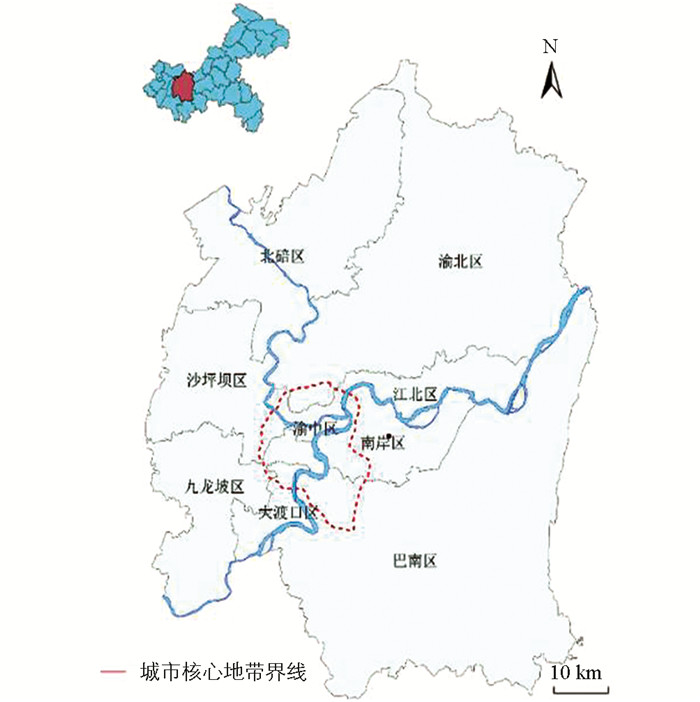
 下载:
下载:


